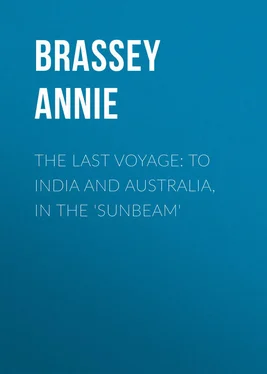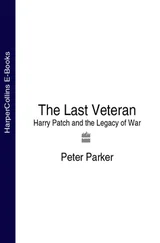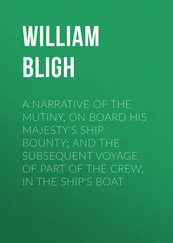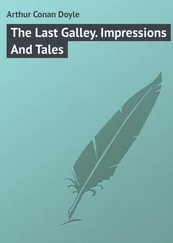Annie Brassey - The Last Voyage - To India and Australia, in the 'Sunbeam'
Здесь есть возможность читать онлайн «Annie Brassey - The Last Voyage - To India and Australia, in the 'Sunbeam'» — ознакомительный отрывок электронной книги совершенно бесплатно, а после прочтения отрывка купить полную версию. В некоторых случаях можно слушать аудио, скачать через торрент в формате fb2 и присутствует краткое содержание. ISBN: , Издательство: Иностранный паблик, Жанр: foreign_antique, foreign_prose, на английском языке. Описание произведения, (предисловие) а так же отзывы посетителей доступны на портале библиотеки ЛибКат.
- Название:The Last Voyage: To India and Australia, in the 'Sunbeam'
- Автор:
- Издательство:Иностранный паблик
- Жанр:
- Год:неизвестен
- ISBN:http://www.gutenberg.org/ebooks/29778
- Рейтинг книги:3 / 5. Голосов: 1
-
Избранное:Добавить в избранное
- Отзывы:
-
Ваша оценка:
- 60
- 1
- 2
- 3
- 4
- 5
The Last Voyage: To India and Australia, in the 'Sunbeam': краткое содержание, описание и аннотация
Предлагаем к чтению аннотацию, описание, краткое содержание или предисловие (зависит от того, что написал сам автор книги «The Last Voyage: To India and Australia, in the 'Sunbeam'»). Если вы не нашли необходимую информацию о книге — напишите в комментариях, мы постараемся отыскать её.
The Last Voyage: To India and Australia, in the 'Sunbeam' — читать онлайн ознакомительный отрывок
Ниже представлен текст книги, разбитый по страницам. Система сохранения места последней прочитанной страницы, позволяет с удобством читать онлайн бесплатно книгу «The Last Voyage: To India and Australia, in the 'Sunbeam'», без необходимости каждый раз заново искать на чём Вы остановились. Поставьте закладку, и сможете в любой момент перейти на страницу, на которой закончили чтение.
Интервал:
Закладка:
A visit to Patiala suggests some general reflections. Under native rule, roads, sanitation, education, everything which belongs to the higher civilisation, is neglected, while money is lavishly spent on elephants, equipages, menageries, jewellery, palaces, and barbaric splendours of every kind. It is a great abuse, much needing correction, that the native states, though they have received from the British complete guarantees against foreign invasion and internal rebellion, maintain armed men, for the vanity of military display, to the number of 315,000.
It would have lightened our burdens greatly if the internal government of India could have been left under native princes. Such an alternative, unfortunately, was not open to us. The native rulers would have proved for the most part incapable of the task. They would have been led on by internecine warfare to mutual destruction. The trade with England depends on the peace which we have been instrumental in preserving.
The gentlemen went out shooting, and we joined them at lunch as before. Paid some visits in the afternoon, and played lawn-tennis at the Bari Durri with the Maharajah. Left Patiala at 8 p. m.
Wednesday, January 26th. – Arrived at Meerut at 5 a. m., and thence continued our journey to Delhi. Drove to dâk bungalow, and thence to the palace, now being partially restored. Public audience-hall, Pearl Mosque, and the entire group of buildings, within the fort at Delhi, are noble examples of Indian architecture. Lunched at United Service Hotel, in the garden of which is the tomb of the Emperor Hamayun.
Thursday, January 27th. – Drove out early to the Ridge, the flagstaff battery, and the big durbar tent. Saw the troops march by, and at rifle practice. After breakfast went with Mr. Cannon to the Kutub Minar, the grandest column in the world; climbed to the top, whence there is a splendid view. Spent the rest of the day in seeing the sights of this wonderful city. Dined at dâk bungalow, and returned to train. Started at 10.48 for Ulwar.
Friday, January 28th. – Arrived at Ulwar at 7 a. m. Messenger from Maharajah to act as our guide. Most lovely palace, not generally shown. Exquisite lace-like marble tracery, especially in Zenana rooms. Both the Maharajah and the Maharanee are at present away. Schinnahal Tank at back, with cupolas, too beautiful for words. We also went to the summer palace and the gardens attached to it, in which, among other things, we saw some schoolboys playing cricket. Both at Ulwar and at Jeypore there are hospitals and medical schools for male and female students.
Saturday, January 29th. – Reached Jeypore at 6 a. m. The Maharajah's secretary and his assistant, both dressed in black, came to meet us at seven o'clock. Drove to Amber, the ancient city of the Rajpoots, now almost uninhabited, except by Fakirs. Lovely drive in the cool morning air. Elephants at foot of hill, and alligators in tank. At the temple a kid is sacrificed every morning, of which fact we saw traces. Visited the palace – an extensive and gorgeous building, with fine specimens of carved marble. Magnificent view from roof. Drove back to Jeypore to breakfast, and found men with specimens of arms, and curiosities of all kinds, awaiting us. Visited School of Art and Museum. Lunched at excellent Kaisar-i-Hind hotel. Then to the palace, which contains endless courts and halls-of-audience, including the celebrated Dewani Khas, of white marble. Ascended to seventh story, by special permission. Extensive view over city. Interview with Maharajah. Saw his stables, trained horses, and fighting animals, and the beautiful Ram Newas Gardens.
Sunday, January 30th. – Arrived at Agra. Went to church and heard a good sermon. Drove to the Taj, 'the glory of the world,' which was not in the least disappointing, high as were our expectations. Dined with Colonel Smith.
Monday, January 31st. – Drove out to Futtehpore Sikri, the favourite residence of the Emperor Akbar, about twenty-five miles from Agra, where there is a lovely tomb, finer than any we have yet seen. German photographer taking views of it. Lunched near the Jain Temple, which contains most curious carvings. Tom says it is remarkable how well some British regiments stand the climate of India. At Agra we saw the Manchester Regiment. After three years at Mooltan, perhaps the hottest station in India, the men were in rude health. They marched the whole distance to Agra. At the time of our visit the men were playing football and cricket, as vigorously as if they were in England. They subscribe for newspapers; they amuse themselves with frequent theatricals. They are fit to go anywhere and do anything.
The prison at Agra is admirably administered. Under the direction of Dr. Tyler, the men are being instructed in trades, by which, when released from confinement, they will be able to earn an honest living. The manufacture of carpets in the prison has been brought to perfection. A similar progress has been made in wood-carving in the prison at Lahore. Throughout India the prisons have been converted, with a wise humanity, into busy workshops.
Tuesday, February 1st. – Left Agra by special train at 3 a. m. and reached Gwalior at seven. Colonel Bannerman, with carriages, kindly met us. After breakfast drove out to the fort, to reach which we had to ride on very shaky elephants up a steep road. Barracks deserted now that the English soldiers are gone. Saw the Jain Temple, restored by Captain Keith. Returned to Gwalior, and lunched at the Residency. Proceeded by 1.45 train to Dholepore. Maharajah received us at station and entertained us with coffee. Reached Agra again at six o'clock.
Wednesday, February 2nd. – Arrived at Cawnpore at 2 a. m. Drove at 6.45 through the streets to the Memorial Gardens, where a monument is erected over the well into which so many victims of the Mutiny were cast. Visited the site of the Assembly Rooms, where women and children were hacked to death. Then to General Wheeler's entrenchment, St. John's Church, and the present Memorial Church, which contains many interesting tablets with touching inscriptions. Proceeded by train to Lucknow. Went with General Palmer to the Residency. Lovely gardens, full of purple bougainvillea, orange bignonia, and scarlet poinsettias. It was difficult to realise that this spot had once been the scene of so much horror and bloodshed. It was in the gardens of the Secundra Bagh that two thousand mutineers were killed within two hours by the 93rd Regiment and the 4th Punjaub Rifles, under Sir Colin Campbell. Lunched at the Imperial Hotel, and afterwards went to the soldiers' coffee-tavern.
Thursday, February 3rd. – Reached Cawnpore at midnight, and Allahabad at 7.20 a. m. Met by Mr. Adam with the Maharajah's carriages, in which we drove to the principal places of interest, including the fort, the arsenal, and the Sultan's serai and gardens. Returned to station and went on by train to Benares. Drove through the narrow and dirty streets to the Golden Temple. Not much to be seen in the shops except London brasswork and Hindoo gods. The Temple was chiefly remarkable for the dirt which abounded. The Cow Temple was dirtier still, with cows and bulls tied up all round it. Monkey Temple very curious. Drove out to the cantonments, several miles from the city. Dined at Clarke's Hotel, and returned to the train very tired.
Friday, February 4th. – Called at 6 a. m. Started at half-past seven for the Ranagar Palace, where we found chairs in readiness to carry us up the ascent. Received by the old Maharajah, his son, and grandson. Embarked in a boat propelled by a treadmill, and proceeded down the river, past all the ghauts and palaces belonging to various kings and princes or to their descendants. The bathing-ghaut was a wonderful sight. Women in brilliant colours; red palanquins and pilgrims. Carriages met us at the bridge.
Читать дальшеИнтервал:
Закладка:
Похожие книги на «The Last Voyage: To India and Australia, in the 'Sunbeam'»
Представляем Вашему вниманию похожие книги на «The Last Voyage: To India and Australia, in the 'Sunbeam'» списком для выбора. Мы отобрали схожую по названию и смыслу литературу в надежде предоставить читателям больше вариантов отыскать новые, интересные, ещё непрочитанные произведения.
Обсуждение, отзывы о книге «The Last Voyage: To India and Australia, in the 'Sunbeam'» и просто собственные мнения читателей. Оставьте ваши комментарии, напишите, что Вы думаете о произведении, его смысле или главных героях. Укажите что конкретно понравилось, а что нет, и почему Вы так считаете.









![John Bruce - The Lettsomian Lectures on Diseases and Disorders of the Heart and Arteries in Middle and Advanced Life [1900-1901]](/books/749387/john-bruce-the-lettsomian-lectures-on-diseases-and-disorders-of-the-heart-and-arteries-in-middle-and-advanced-life-1900-1901-thumb.webp)


